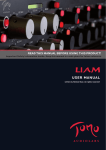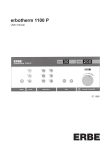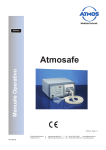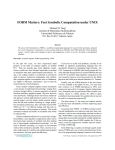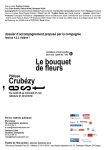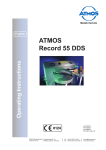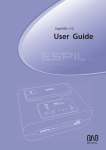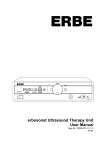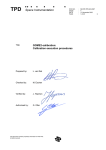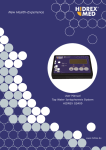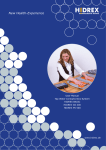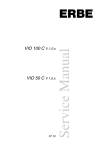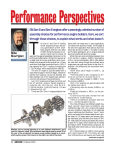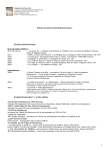Download erbotherm 12 250 P - Frank`s Hospital Workshop
Transcript
erbotherm 12 250 P User manual 01.2001 1 2 ERBE erbotherm 12 250 P Operating Instructions 3 Manual part number: 80120-031 erbotherm 12 250 No. 10202-030 All rights reserved. No part of this document may be translated, stored in information retrieval systems, or transmitted in any form or by any means - electronic or mechanical, including photocopying, recording or otherwise - without the written permission of ERBE Elektromedizin. Printed by: ERBE Elektromedizin Printed in Germany Copyright © ERBE Elektromedizin GmbH, Tübingen 2000 4 5 6 Contents Chapter Title ................................................................................................... Page 1 Introduction ..............................................................................................9 2 Prior to commissioning ........................................................................... 11 3 Operation of the erbotherm 12 250 ........................................................12 4 Safety .....................................................................................................14 5 Technical data ........................................................................................17 7 8 CHAPTER 1 Introduction Application of the microwave thermotherapy The microwave therapy unit erbotherm 12 250 P is a thermotherapy unit operating in the microwave frequency range. The therapy can be performed in the continuous as well as pulsed mode of operation and, thus, it is very suitable for a lot of applications in hospitals and doctor’s consulting rooms. The application of high-frequency energy in the thermotherapy offers the advantage of a deeper penetration in comparison with the conventional methods like packs, baths, infra-red light irradiation and heating pads. In addition, it enables a well directed heating up of certain parts of the body or organs. The endogenously generated heat releases quite a number of physiologic processes by which, for instance, muscles, tendons and other connective tissue structures are spasmodically influenced, the cell metabolism and enzyme reaction speeds are increased and the blood circulation is supported within the range treated. Due to the possibility to apply the energy in pulses of considerably larger power in comparison with the continuous mode of operation the depth effect and particularly the blood circulation supporting effect can be additionally risen while there is not detectable any increase in the heat stimulation of the thermo-resistent skin. The field of application of the RF thermotherapy is very wide. At first, there are to be mentioned all the rheumatic diseases of joints and muscles, inflammations of the respiratory system, kidneys and urinary tracts and all diseases basing on an insufficient blood circulation. Acute processes are preferably treated in the pulsed mode of operation. The thinner cable (50 W) is provided for the contact, rectal and vaginal radiators. The contact radiator can be held in the hand or alternatively fixed at the supporting arm. The nose/ear radiator is provided with a fixed connecting cable. WARNING Mains connection We deliver the microwave therapy unit erbotherm 12 250 P for mains voltages of: 230 V a. c. ± 10 %, 50/60 Hz 115 V a. c. ± 10 %, 50/60 Hz Thus, prior establishing the mains connection the statement of the name plate has to be checked fort he real value. Only in case of correspondence of the mains supply voltage with the statement on the unit the mains connection is to performed. For this purpose, please, use only the special mains cord delivered including an adapter, if required, for your installation system. 9 With using another cable an interference of other electric units is possible. The wall outlet socket with earthing contact used should be secured by a fuse of at least 10 A. Any changing of the microwave therapy unit erbotherm 12 250 P to other mains voltages, if required, shall only be performed by authorised service shops. WARNING Installation The unit is not designed for operation at hazardous locations. In the same way the unit is not allowed to be operated in wet rooms. Previous to any cleaning or disinfection the unit is to be switched off and the mains plug drawn out of the wall socket. For cleaning and disinfection of unit and accessories we recommend to use commercial disinfectants (e.g. Hexaquart S, Quatohex) in accordance with their operating instructions. Do never use solvents as for instance benzene or the like. During cleaning and disinfection it is to be observed that no fluids penetrate into the unit or parts of accessories. Wet plug connector contacts are to be carefully dried in advance of any further use. 10 CHAPTER 2 Commissioning The unit is designed as movable floor-type unit on guide rollers where two of which can be locked. All control and display elements required are arranged at the unit’s control panel. The mains switch is arranged at the upper left side of the unit. The screw positions of the radiator supporting arm are found at the rear side of the unit. Supporting arm Due to it’s sophisticated design the supporting arm offers the possibility of a very simple positioning of the radiators in the different treatment situations. In doing so, only the corresponding screws at the joints are to be unlocked by about a half turn and, after the repositioning of the supporting arm desired, they are to be fixed by the corresponding clockwise turning. At any time, the supporting arm can be arrested in dependence on the different weights of the radiators by means of the round fixing knob. Radiators For the numerous applications, we offer the suitable types of radiators. The most advantageous type of radiator is to be taken from the special literature or from our application table enclosed. The useful radiator power which is maximum possible for the corresponding application is automatically recognised in dependence on the radiator used by the microwave therapy unit erbotherm 12 250 P itself and displayed at indicators (3). The connection pipes of the spot, long and trough-type radiators are put into the receptacle of the supporting arm head up to the radiator seat engagement indicated by an audible click. Taking off is performed by a slight drawing out of the radiator after having pushed back the slide member against the spring tension. The contact, rectal and vaginal applicators may only be held in the hand. With all these radiators the electric connection to the unit is performed by means of the 250-W cable. Please, take care for the audible click when special coupling is engaging so that any accidental loosening of the cable is not possible at a later time. 11 CHAPTER 3 Operation of the erbotherm 12 250 P The operation of the microwave therapy unit erbotherm 12 250 P is to be performed very simply from the left to the right side. Before switching on the unit, it is to be ensured that the selection and fixation of the radiator is performed in accordance with the therapeutic treatment prescribed. 1. Switch on the mains switch located at the left side of the control panel. 2. Select the mode of operation by pressing push-button (1) or (2): Push button (1): Continuous operation Push button (2): Pulsed operation The mode of operation selection is optically acknowledged by an indicator integrated in the push-button 3. The maximum microwave output power adjustable in dependence on the radiator selected is indicated at the automatic display of the type of radiator connected (3). 4. Now, the treatment time desired is to be selected by means of the pushbuttons (7). Every single pressing of the push-buttons increases the treatment time by 1 min, but continuous pressing automatically rises the treatment time in 5 minute steps. Thus, any treatment time between 1 min and 30 win can be easily selected. The time can also be changed during the treatment. The display continuously shows the remaining time up to the end of the treatment. The end of the programmed treatment period is indicated by an acoustic signal. At the same time the RF output power is automatically switched off. To ensure a safe monitoring of the treatment it is intended to manually switch off the acoustic by turning the power knob to the left. If this switching off is not performed within 30 s the unit is automatically switched into stand-by mode then. The selected mode of operation is maintained. 5. The microwave output power is selected by means of knob (6). By a slight left-hand turning the automatic control is caused to adjust the unit to the radiation conditions (type of radiator, patient, etc.) given. This is performed within only a few seconds and then signalled by the symbol ,,Ab“ at the therapy time display. When the display has been automatically reset to the time adjusted the output power desired can be selected by right-hand or lefthand turning in dependence on the type of radiator connected. 12 Turning the output power knob selection knob shows no clicks. In the interest of the patient, the output power should be increased very carefully in any case, i. e. the patient should be asked for the temperature experienced. Any resetting the output power to zero results in a subsequently performed shorttime adjustment since the unit recognises this procedure as a possible changing of the radiator position. If a erroneous operation has been accidentally performed the microcomputer running in parallel ensures that neither the patient nor the operator will be endangered in anyway. In this case the code ,,FE 0“ (error: 0) is indicated at the output power display (5). If this happened, the operator should inform on the correct operation of the microwave therapy unit erbotherm12 250 P by reading the Operating instructions. After the unit has been switched off or a short time (approximately 3s) the treatment can be continued in accordance with the Operating instructions. When the indicator (3) for the type of radiator connected is not lit and the symbol FES as well as an acoustic pulsed signal do not appear with full output power it is to be checked whether the radiator-cable-unit connection has been correctly performed or not. The signalling is switched off when the given radiator has been correctly connected and the unit is restarted by two actuation’s of the mains switch. When, despite of the test of the plug connections and, if required, exchange of the radiator, the error cannot be eliminated or other errors are indicated, contact your the service shop and informed on the error symbols. 13 CHAPTER 4 Safety WARNING Safety information and safety regulations As the manufacturer of electromedical units we consider to be responsible for the safety features of this unit only when the erbotherm 12 250 P is operated in accordance with the present Operating instructions. Maintenance and repair work shall only be performed by our company or contract-service workshops especially authorised by us. Prior to any taking into operation the user or his responsible staff must ensure that all safety devices correctly operate and the unit is ready for operation. In the interest of the safety of patients, operators and third persons we recommend a regular safety test to be performed in a time period of maximum 52 weeks. Since the operation of high-frequency devices requires official approval the unit has to be announced at the relevant branch office of the responsible telecommunication board of your country by the announcement card enclosed. During the treatment the waiting patients that are not treated shall not be within a distance of less than 1.5 m to the radiator. Heat effect of radiators The subjective assessment of the heat effect of radiators is largely influenced by quite a lot of factors, e. g. the thickness of fat layers in the tissue, treatment through different clothes, blood circulation, skin temperature, etc. The basic measure for evaluating the blood circulation is the heat experience of the patient. Thus, it is very important to ask for the temperature felt by the patient. Due to the very sensitive thermoreceptors in the skin any overdose can be excluded. However It is to be observed that, as a rule, the heat experienced in accordance with the output power selected is felt only after several minutes. Every patient has another temperature sensitivity and, thus, also its temperature feeling depends on quite a lot of factors (among others: the ambient temperature) and must be repeatedly asked for. During the cold seasons the skin is especially sensitive to already relatively low temperature differences. For this reason, the treatment should only be started when the patient is conditioned to the room temperature. Warming up the contact radiators by the hand prior to their application is also very advantageous. Scars in the area to be treated can cause sensitivity disturbances. In such a case, the dose applied should be lowered down in accordance with the subjective experience. 14 Locally anaesthetized body regions should generally not be treated. Otherwise, burning could be the result of the completely missing temperature sensitivity. For information we enclosed a treatment table to the unit which includes recommendations for suitable treatment times and output doses for different applications on the basis of the long lasting experiences made at the Institute of Physiotherapeutics Lena (Medical director: Prof. Dr. med. R. Callies). For an optimum therapy the patient or his/her part of the body to be treated should be completely relaxed. The precondition for this is that the patient’s position is as comfortable as possible. Metallic objects, as for instance watches, rings, bracelets, chains, hearing aids and the like, are to be taken off. Objects that are possibly in the trousers pockets shall not be forgotten. Electronic devices (e. g. watches, pocket calculators, hearing aids, etc.) can be destroyed by the high-frequency field in the worst case. These precautions are also valid for persons in the immediate vicinity of the unit as well as for the operating staff. Due to the increased heating up of wet clothes it is advisable to undress the body regions to be treated. This is particularly applicable to areas of increased perspiration. Skin folds are to be dried, if required. Patients with metallic prostheses should not be treated at these positions and generally by only very low doses. To protect tissues that contain mainly fluids, like eyes ortesticles, from any damage it is to be ensured that they are not in the radiated area or, otherwise, protective means are to be applied, e. g. safety glasses. As a rule, the radiator applied shall be adapted to the area to be treated. This ensures optimum success and safe application. High frequency electromagnetic fields According to its designation the appliance generates high frequency electromagnetic fields that penetrate even walls, ceilings and floors. It cannot be excluded that components of these fields exists in the vicinity of the appliance. Sensitive electronic instruments which are arranged in the immediate vicinity of the 12250 P can be disturbed. This danger largely depends on the distance between the devices. Therefore, during the installation of the appliance, it should be taken into consideration that the distance to other sensitive devices should exceed 5 m, if possible, and the applicators are not directed to sensitive devices, as for instance current stimulators. This problem can be completely eliminated when the appliance is accommodated in a shielded room, that means in a Faraday cage. A Faraday cage enclosed by a metal housing prevents the penetration of electromagnetic fields. 15 Special groups of patients Patients which shall not be treated: • Patients with implanted pacemakers and cochlea implants. • Patients with metallic endoprostheses at the areas to be treated. • Patients with malignant tumours. The treatment of such patients must only be performed by doctors with special knowledge on that disease. • Patients with acute tuberculosis and other specific diseases. Patients which shall be treated very carefully: • Patients with acute infectious diseases particularly if they have an increased temperature. • Patients with acute inflammable bone and joint diseases. Due to the heat generated by the treatment a tissue necrosis may be possibly stimulated or accelerated. In addition, the low blood circulation in such regions may result in an additional heat accumulation. The application of the microwave thermotherapy in cases of ischaemia orserious tissue damage is to be performed very carefully. • Patients with traumata and vascular lesions during the first 24 to 36 hours after the event because to the hazard of a secondary haemorrhage. • Patients with tendency to thromboses. • Regions that are anaesthetized. • Osteoporosis. • Patients with increased tendency to haemorrhages. • Female patients in the range of the lower abdomen during the menstruation. • Female patients with intra-uterine pessaries. • Pregnant patients. • The application of the microwave therapy in the vicinity of the eyes. With treatments on the head the eyes are to be protected always by safety glasses, otherwise, there is the hazard of going blind. The treatment of the eye should only be performed by an ophthalmologist. • Patients with contact lenses since these decrease the heat elimination and, thus, support the heat accumulation. • Treatment in the vicinity of the testicles. These are particularly sensitive to heat. Any overheating may very quickly result in permanent damage up to sterility. • Pregnant patients. Take care for the corresponding protection of the foetus or embryo, respectively. Infants should be treated in undressed condition. The output power must be readjusted to the optimum by means of repeatedly checking the skin temperature. Infants and old patients shall not be unattendedly treated for a longer time. ATTENTION This information does not claim to be complete. In any special case the treatment criteria have to be defined only by the doctor. 16 CHAPTER 5 Technical Data Mains voltage switching over in the unit 230V +/- 10%, 50/60 Hz 115V +/- 10%, 50/60 Hz Electric fuses 4 A slow acting 230 V 6,3 A slow acting 115 V Protective system Class I Power consumtion 600 W Frequency 2450 MHz +/-50 MHz RF output power at 50 Ohm Pulsed mode and continous mode, three power ranges each 250 W, 50 W, 10 W Peak plused output power approx. 1600 W in the 250-W range Structure of the appliance and test according to EN 60601-1/1990 EN 60601-1-2/1994 IEC 601-2-6/1984 Dimensions 85 x 38 x 39 cm Weight approx. 40 kg Output coaxial 50 Ohm Permission in conformity with the direction 93/42/EWG 17 18


















